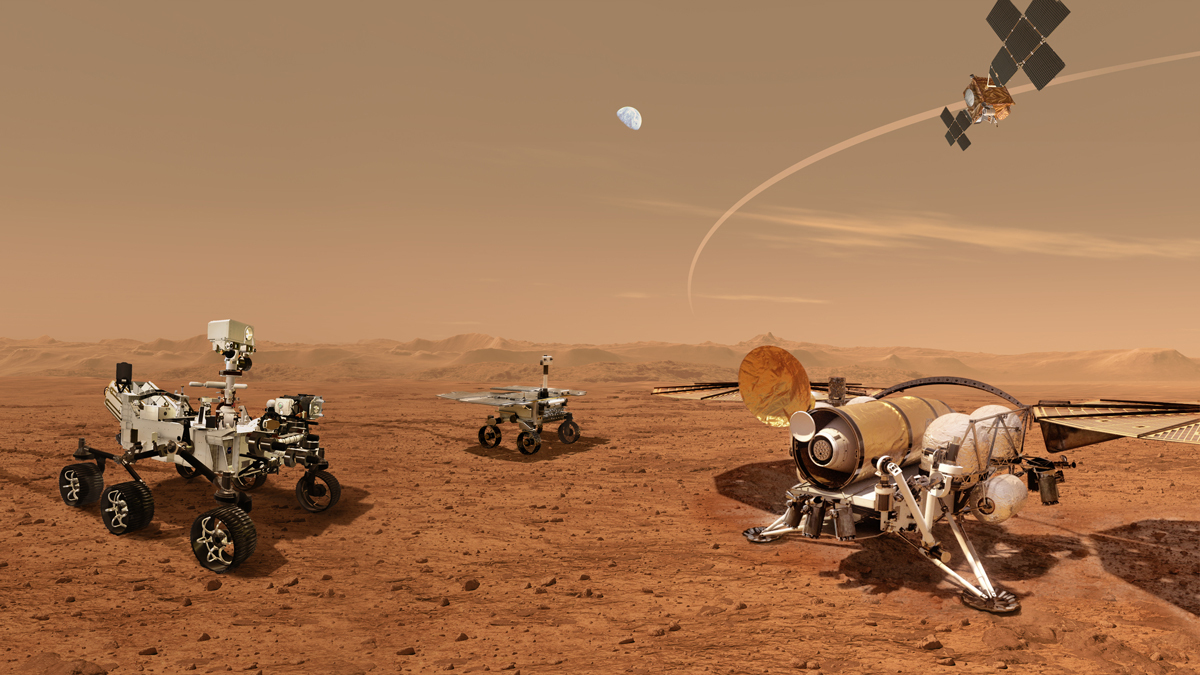NASA is going to launch a rocket from another planet for the first time ever
NASA's two Mars rovers, Perseverance and Curiosity, are currently exploring the red planet to learn more about its history and to search for evidence that there could once have been life there. But these are just the first stages in exploring Mars. To really learn about the make-up of the planet, and to confirm if there could be signs of ancient life there, we need to get a sample from Mars and bring it back to Earth.
That's not an easy task, though. As complicated as it is to land a rover on Mars, it's perhaps even harder to launch a rocket from its surface. That's partly because of environmental issues, like the very small amounts of oxygen in the atmosphere which makes it hard to burn rocket fuel, and partly because of infrastructure issues, because there are no launchpads on other planets.
Still, NASA is taking on this challenge with its Mars Sample Return program. The idea is that the Perseverance rover will collect samples and seal them in tubes as part of its mission, then leave the sealed tubes on the planet's surface. Then, a future rover will be sent to Mars to collect those tubes and bring them back to a launch site where they will be loaded up into an ascent vehicle. The ascent vehicle will launch into orbit – becoming the first rocket to launch from another planet – and release the samples. These would then be collected by an orbiting spacecraft, and that spacecraft will bring the samples back to Earth.
That sounds complicated – and it is! – so NASA is getting help from private companies with parts of the mission. Recently, the agency announced it has awarded a contract to the company Lockheed Martin to build the Mars Ascent Vehicle (MAV) which will carry samples from the martian surface into orbit.
"This groundbreaking endeavor is destined to inspire the world when the first robotic round-trip mission retrieves a sample from another planet – a significant step that will ultimately help send the first astronauts to Mars," NASA Administrator Bill Nelson said. "America's investment in our Mars Sample Return program will fulfill a top priority planetary science goal and demonstrate our commitment to global partnerships, ensuring NASA remains a leader in exploration and discovery."
 Credits: NASA/ESA/JPL-Caltech
Credits: NASA/ESA/JPL-Caltech
NASA acknowledges the challenges of building an ascent vehicle, stating that it will have to be able to withstand the harsh martian environment, where it can expect to face cold temperatures and difficult dust, as well as a thin atmosphere with little oxygen. The vehicle will also need to be compatible with the rover which collects the tubed samples, being developed by NASA, and be capable of releasing a sample to be collected the orbiting spacecraft, being developed by the European Space Agency. It will have to fit inside a lander which will carry it to Mars, called the Sample Retrieval Lander, as well.
The aim is to launch the Sample Retrieval Lander in 2026. Before then, the MAV will have to be designed, developed, tested, and integrated. The contact is for $194 million and is set to begin this month and run for six years.
"Committing to the Mars Ascent Vehicle represents an early and concrete step to hammer out the details of this ambitious project not just to land on Mars, but to take off from it," said Thomas Zurbuchen, the associate administrator for science at NASA Headquarters in Washington. "We are nearing the end of the conceptual phase for this Mars Sample Return mission, and the pieces are coming together to bring home the first samples from another planet. Once on Earth, they can be studied by state-of-the-art tools too complex to transport into space."
